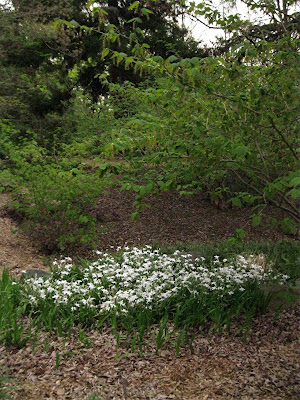Of course a gardener's least favorite aphorism is, "here today, gone tomorrow". Unless we're talking about cherry petals on the ground.
Sometimes you can do small easy things in the garden to make things flow more smoothly and prevent remedial work down the line.
We, the volunteers and I, planted these
Pinus koraiensis last year. At Carole's suggestion, I caged them against deer damage. This morning I walked through and quickly shortened the side shoots at the apex of the plant. The pictures are in reverse chronological order: the bottom picture shows how the plant looked when I got to it, the top picture is the same plant after I half-candled it. We want these trees to grow upright with a nice straight single trunk. By reducing the size of all the candles at the tip of the plant except the central one, I ensured apical dominance. I didn't want to completely remove the side shoots because as they grow needles they'll contribute to the growth and strength of the trunk, but I don't want any of them developing into alternate leaders.
Often a little attention to a young plant will pay off down the road. We want all of our plants to develop into living examples of the "Platonic Ideal" of their given taxon. In a perfect work all we'd have to do is plant and wait.....in this world there are innumerable variables that will conspire to keep our plant from being perfect: a small bit of damage to a seedling might affect the symmetry of its growth; damage to one side of the root system, or inconsistency in the soil, or more light from one side, or damage from a falling branch, crowding in the nursery. And on and on. In the face of this, all we can do is be aware of what we're shooting for, know how the plant grows, pay attention, and, as required, do corrective manipulations.l.



















